Topic 8: Metabolism, cell respiration and photosynthesis (HL)
8.2 Cell respiration
Oxidation and reduction (OIL RIG)

Electron carrier in respiration
Electron carriers are substances that accept and give up electrons so they can transfer and save energy. There are two types of electron carriers involving in cell respiration
- NAD:\(NAD^+\)⇋ NADH(forward reaction in reduction)
- FAD: \(FAD^+\) ⇋ \(FADH_2\)(forward reaction in reduction)
- During respiration NAD which actually exists as \(NAD^+\) accepts 2 electrons and a proton \((H^+)\) from the molecule being oxidized (like pyruvate) to form NADH with one extra \(H^+\) leftover as a product, in which \(NAD^+\) is reduced into NADH
- After the electron carriers are reduced, they will be transported to electron transport chain, in which, electron carriers will be oxidized and release protons and electrons into inter-membrane space
Glycolysis

Link reaction
Pyruvate is not allowed to enter the mitochondria, so coenzyme A comes and breaks pyruvate (3 carbon molecule) Into acetyl CoA (2 carbon molecule) and a single carbon molecule, which is eventually bind with 2 oxygen atoms to form carbon dioxide. For every glucose molecule, it will go through twice link reaction
- Decarboxylation is a chemical reaction that removes a carboxyl group and releases carbon dioxide \((CO_2)\).
- Oxidation is the loss of electrons or an increase in oxidation state by a molecule, atom, or ion. Pyruvate is oxidized by the by the removal of pairs of hydrogen atoms (with their electrons), which are passed on the \(NAD^+\) and FAD
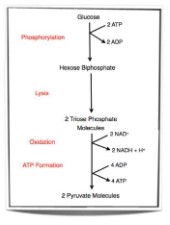
Krebs cycle
- Acetyl Co A is a two carbon molecule that transfers the acetyl group to the four carbon molecule oxaloacetate to form the six-carbon compound citrate (6C).
- Citrate is decarboxylated (released as carbon dioxide) and \(CO_2\) is excreted as a waste product with the \(CO_2\) from link reaction.
- Citrate is also oxidized and \(NAD^+\) is reduced to form NADH.
- The C5 molecule formed is further oxidized and decarboxylated to form another \(CO_2\) molecule (excreted as waste) and another NADH.
- At this point all the carbons from the original pyruvate molecule have been released as \(CO_2\).
- The C4 molecule undergoes changes to regenerate the original oxaloacetate (C4) molecule, further producing a NADH, a \(FADH_2\) and an ATP through a series of redox reactions.
- The products produced by the Krebs cycle are used in electron transport chain to make ATP.
- Final products for one glucose molecule: 2 ATP, 6 NADH, 2 \(FADH_2\)and 4 \(CO_2\)(excreted).
- For every glucose molecule, it will go through twice kerbs cycle
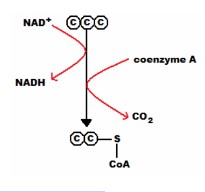
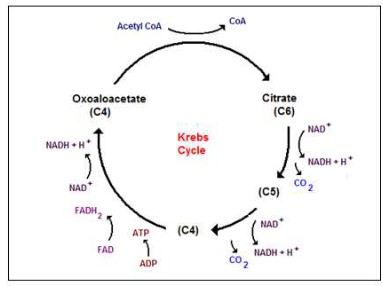
Electron Transport Chain and Chemiosmosis
- The chain is a series of electron carriers located in the inner membrane of mitochondria that pass electrons from one carrier to the next down an energy gradient.
- NADH supplies 2 electrons to the first carrier in the chain (reforming \(NAD^+\). These electrons move along the chain of electron carriers giving up energy each time they pass from one carrier to the next.
- \(FADH_2\) is also oxidized (forms \(FAD^+\) releases its electrons a little later into the electron transport chain.
- Energy is released as the electrons are passed along the carrier proteins.
- This energy is used to pump \(H^+\) ions across the inner mitochondrial membrane from the matrix to the inter-membrane space.
- This accumulation of \(H^+\) ions in the inter-membrane space creates an \(H^+\) concentration gradient between the matrix (less concentrated) and the inter-membrane space (more concentrated)
- Protons \(H^+\) flow back from the inter-membrane space to the matrix through special protein channels located in the inner mitochondrial membranecalled ATP synthase.
- As the protons pass across the membrane, they release energy, which is used by the ATP synthase to produce ATP through a phosphorylation reaction.
- This process is called oxidative phosphorylation because oxygen is the final electron acceptor and the energy released by reducing oxygen to water is used to phosphorylate ADP and generate ATP.
- For each glucose molecule, about 32 molecules of ATP are produced.
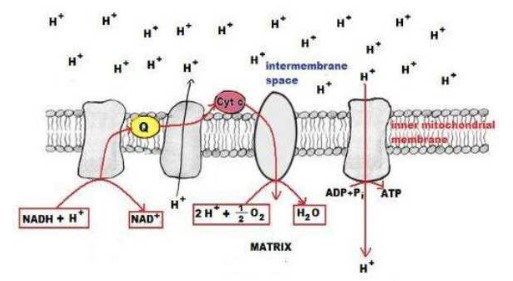
Summative table of cell respiration
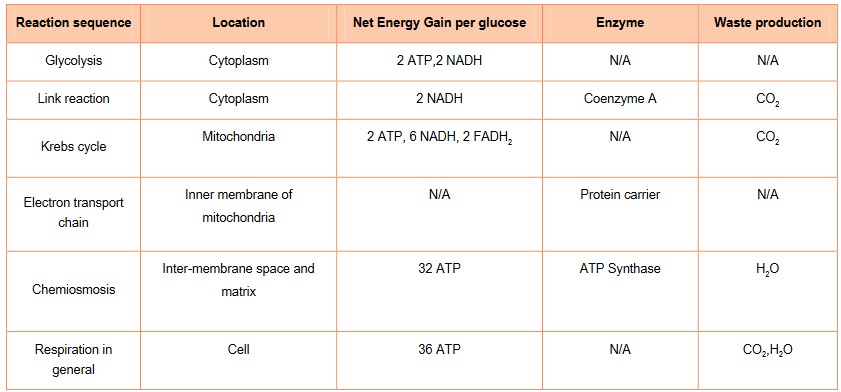
Role of oxygen
- At the end of the ETC, electrons are given to oxygen. Oxygen accepts hydrogen ions and forms water (known as the terminal acceptor).
- If oxygen is not available, electron flow along the ETC stops and NADH + \(H^+\) cannot be reconverted to \(NAD^+\).
- Supplies of \(NAD^+\) in the mitochondrion run out and the link reaction and Krebs cycle cannot continue.
- Glycolysis can continue because conversion of pyruvate into lactate or ethanol and carbon dioxide produces as much \(NAD^+\) as is used in glycolysis.
- Therefore oxygen is necessary for aerobic respiration to take place.
- Also, by using up the hydrogen to form water, the proton gradient across the inner mitochondrial membrane is maintained
Functions of different parts of mitochondria

